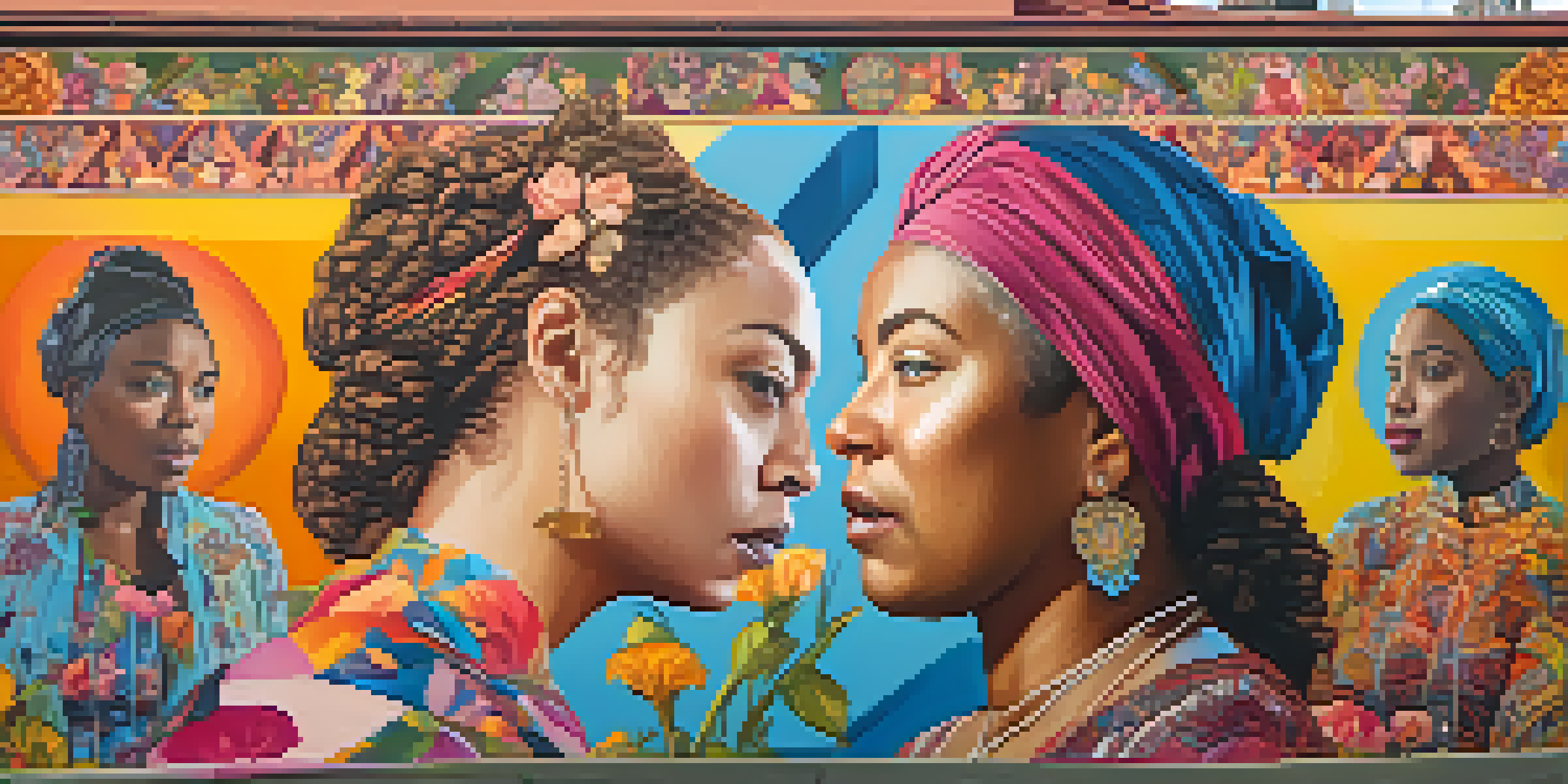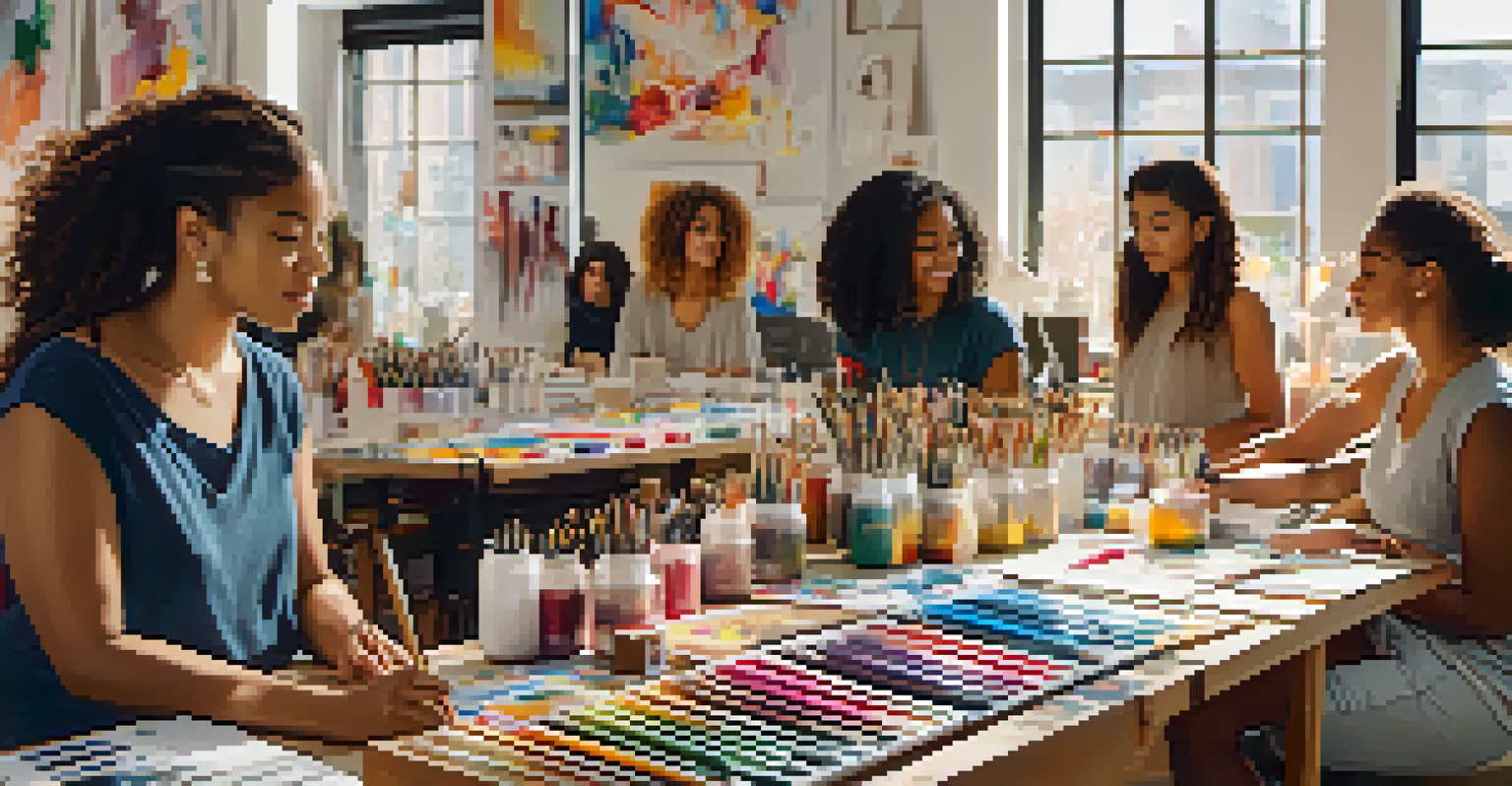The Intersection of Art and Activism in Feminist Movements

Understanding Feminist Art as a Form of Activism
Feminist art serves as a powerful tool for social change, allowing artists to express their beliefs and challenge societal norms. By addressing issues such as gender inequality, violence against women, and reproductive rights, artists can raise awareness and inspire action. This form of art often blurs the lines between creative expression and political activism.
Art is not a mirror held up to society, but a hammer with which to shape it.
For instance, the iconic 'The Dinner Party' by Judy Chicago combines art with a feminist message by celebrating women's history and achievements. Such works not only provoke thought but also encourage dialogue about the struggles women face. Consequently, feminist art becomes a means to mobilize communities and galvanize support for various causes.
Ultimately, feminist art challenges viewers to confront uncomfortable truths, making it an essential aspect of the broader feminist movement. It empowers individuals to question prevailing narratives, fostering a sense of solidarity among women and allies. This intersection of art and activism can lead to meaningful change, both culturally and politically.
Historical Context: Art in Early Feminist Movements
The roots of feminist art trace back to the late 1960s and early 1970s, coinciding with the women's liberation movement. Artists began to use their work to address the systemic oppression of women, often drawing inspiration from personal experiences. This period marked the emergence of a distinct feminist aesthetic that aimed to reclaim women's narratives.

In this context, artists like Barbara Kruger and Cindy Sherman used photography and text to critique gender roles and societal expectations. Their provocative imagery challenged traditional representations of women and questioned the male gaze in art. By doing so, they laid the groundwork for future generations of feminist artists who continue to push boundaries.
Feminist Art Drives Social Change
Feminist art serves as a powerful tool for activism, addressing issues like gender inequality and inspiring community action.
This historical backdrop highlights how art has always been intertwined with activism, serving as a reflection of societal issues. The bold voices of early feminist artists not only inspired their contemporaries but also established a legacy that resonates in today's feminist movements. Their work reminds us that art can be a catalyst for change.
Modern Feminist Art: A Diverse Landscape
Today, feminist art has evolved into a vibrant and diverse landscape that reflects the multifaceted experiences of women around the globe. Contemporary artists draw from various mediums, including digital art, performance, and installation, to convey their messages. This diversity allows for a richer exploration of intersectionality within the feminist movement.
The personal is political.
Artists like Ai Weiwei and The Guerrilla Girls utilize their platforms to address issues of race, gender, and identity, expanding the conversation beyond traditional feminist themes. Their works often incorporate humor and satire, making complex topics more accessible to broader audiences. This approach not only engages viewers but also encourages critical thinking about contemporary social issues.
Moreover, social media has played a pivotal role in amplifying feminist art, allowing artists to reach wider audiences and connect with global movements. Platforms like Instagram have become spaces for activism and representation, where artists can share their work and engage with followers. This modern landscape underscores the idea that art remains a vital tool for activism, continually shaping dialogues around feminism.
The Role of Community in Feminist Art Activism
Community plays a crucial role in the intersection of art and activism, fostering collaboration and solidarity among artists and activists alike. Many feminist art initiatives are rooted in grassroots movements that seek to uplift marginalized voices. These collective efforts create safe spaces for artists to express themselves and challenge societal norms together.
For example, organizations like the Feminist Art Project and Women’s March Art can provide platforms for artists to showcase their work while advocating for social change. These communities not only amplify individual voices but also cultivate a sense of belonging and support. The power of unity in these spaces can transform art into a collective force for activism.
Community Strengthens Artistic Voices
Collaboration within communities amplifies marginalized voices, transforming art into a collective force for social change.
Additionally, community engagement allows for diverse perspectives to be heard and recognized, enriching the feminist narrative. By collaborating with activists and community organizers, artists can create impactful work that resonates with a broader audience. This dynamic relationship emphasizes the importance of community in driving feminist art forward.
Art as a Tool for Education and Awareness
Art has an incredible ability to educate and inform, making it a powerful tool for raising awareness about feminist issues. Through visual storytelling and emotional resonance, artists can engage viewers on a deeper level, encouraging them to confront challenging topics. This educational aspect of art can spark important conversations and inspire action.
For instance, installations that depict statistics related to domestic violence or reproductive rights can drive home the urgency of these issues. By translating complex data into relatable visuals, artists can help demystify these topics for the public. This approach often elicits empathy and motivates individuals to get involved in advocacy efforts.
Moreover, workshops and community events that involve art-making can empower individuals to express their thoughts and feelings about feminism. These experiences not only foster creativity but also encourage participants to explore their identities and experiences. In this way, art becomes a pathway for education, activism, and personal growth.
Challenges Faced by Feminist Artists Today
Despite the progress made in feminist art, artists still face numerous challenges in their quest for visibility and recognition. Gender bias in the art world remains a significant hurdle, with women artists often receiving less attention and fewer opportunities than their male counterparts. This disparity can hinder their ability to share their work and message effectively.
Additionally, funding for feminist art projects can be limited, making it difficult for artists to bring their visions to life. Many rely on grants and donations, which can be competitive and restrictive. This financial strain can stifle creativity and prevent artists from fully exploring their ideas.
Challenges for Feminist Artists Persist
Despite progress, feminist artists face challenges like gender bias, funding limitations, and backlash for addressing controversial topics.
Furthermore, backlash from conservative audiences can pose challenges for feminist artists who tackle controversial subjects. Criticism and censorship are common, which can discourage artists from pushing boundaries. Despite these obstacles, many feminist artists continue to persevere, using their work to challenge societal norms and advocate for change.
The Future of Art and Activism in Feminist Movements
The future of feminist art and activism is bright, with emerging artists and new technologies reshaping the landscape. As younger generations become more engaged with social issues, they are using digital platforms to amplify their voices and share their art. This shift presents exciting opportunities for collaboration and innovation within the feminist movement.
Moreover, as the conversation around intersectionality continues to grow, feminist art will likely reflect a broader range of experiences and identities. Artists will increasingly draw upon their unique backgrounds to explore complex themes related to race, class, sexuality, and ability. This evolution will enrich the dialogue within feminism and create a more inclusive movement.

Ultimately, the intersection of art and activism will remain a vital force in driving feminist movements forward. As artists continue to challenge norms, inspire action, and foster community, they will play a crucial role in shaping a more equitable world. The potential for change through creative expression is limitless, reminding us that art can be a powerful vehicle for social justice.